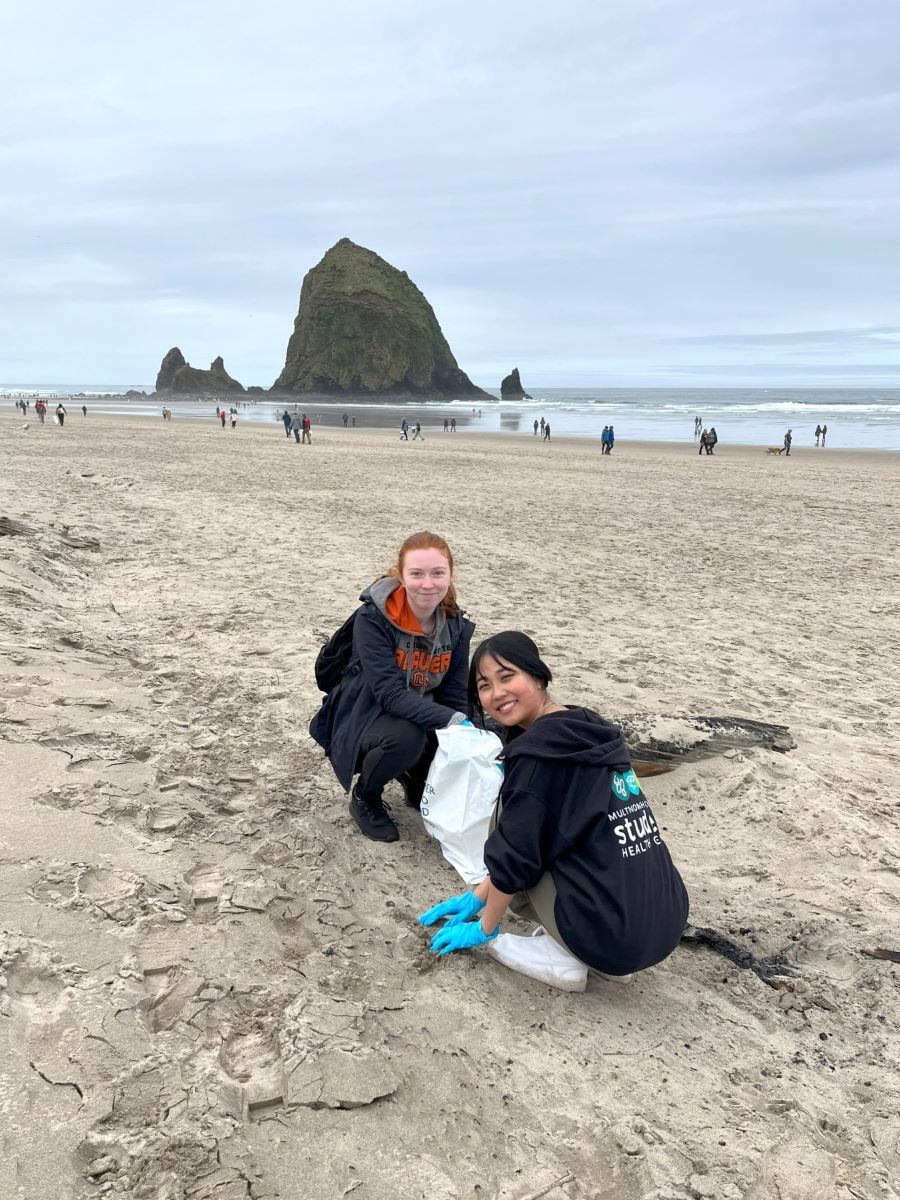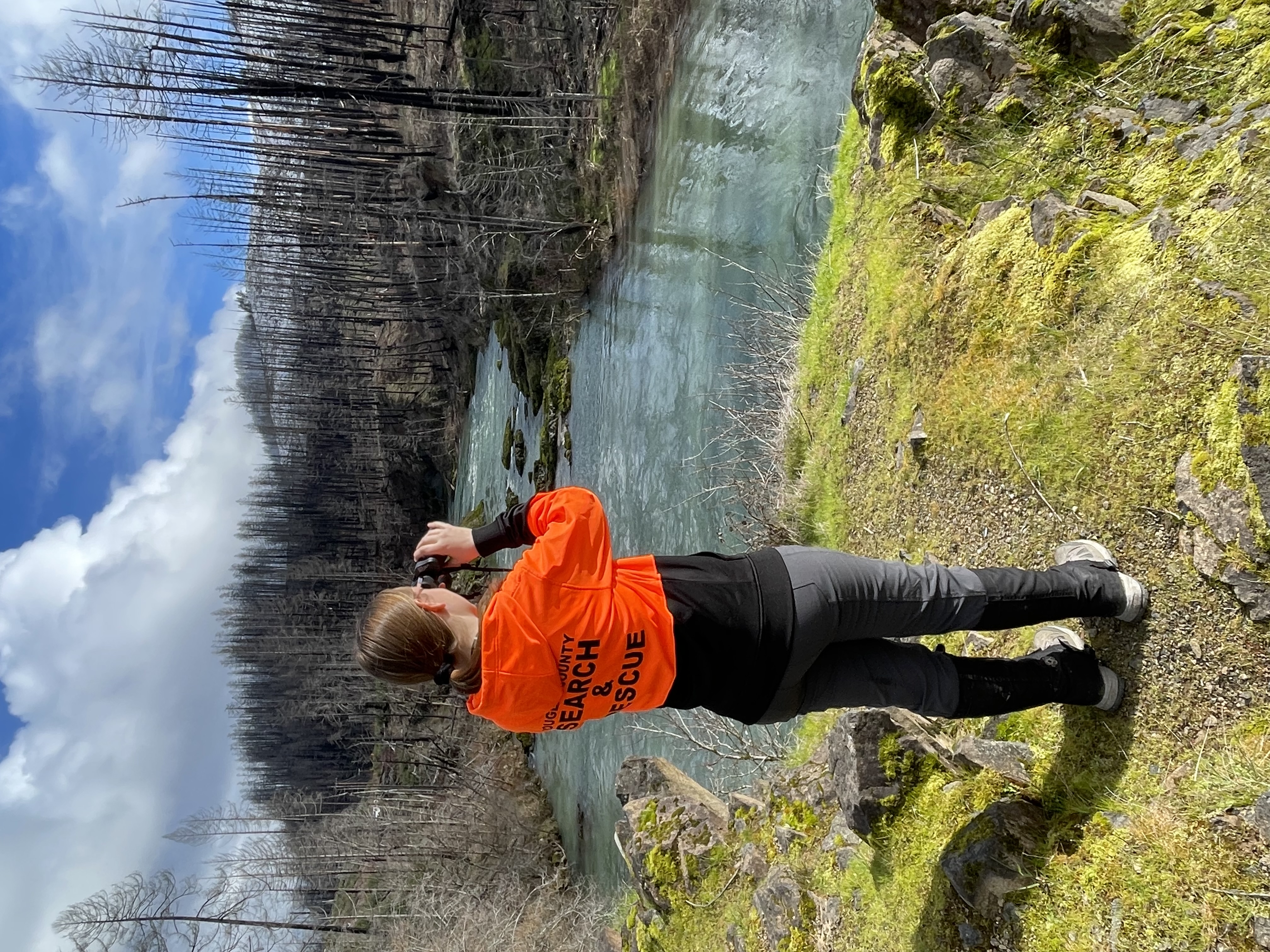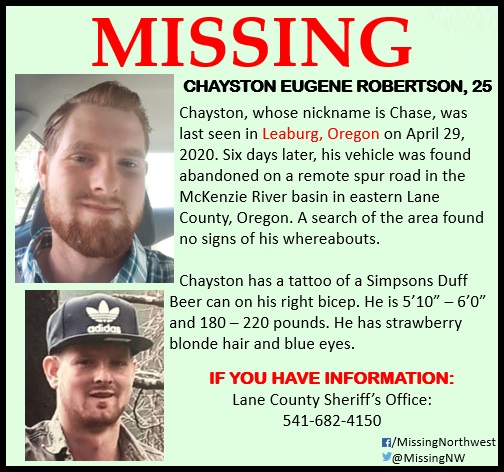The latest news stories and stories of interest in the Willamette Valley from the digital home of Southern Oregon, from Wynne Broadcasting’s WillametteValleyMagazine.com
Friday, April 12, 2024
Willamette Valley Weather



Eugene Police Investigating Attack by Groups of Teens At Valley River Center
Eugene Police are investigating an alleged attack against a group of teenagers at Valley River Center that happened on Monday.

Officers responded to the scene just after 7 p.m. where they learned a group of teenage boys had been following and taking pictures of a group of teenage girls, according to a police department release.
One of the teenage boys accompanying the girls asked the group of teenagers to stop taking photos because it was making the girls uncomfortable.
The group of girls asked a security guard to speak with the group of teenage boys, which he did, according to the release.
As the group of girls were walking to their car in the parking lot, the group of teenage boys aggressively drove to where they were and attacked the boy with them, jumping out of their car and surrounded him, according to the release.
The boy ran and three of the teenagers chased him. As the victim reached the mall entrance doors, one of the teenagers pepper sprayed him in the face and continued chasing him once inside the mall, according to the release.
The suspected teenagers stopped chasing the victim, who was able to find a safe place to try and flush his eyes with the help of a store employee.
The victim told officers that the teenagers had also spit on him and hit him in the back of the head multiple times. The incident was still under investigation as of Wednesday.
The City of Eugene Facing a $11-15 Million Funding Shortfall
The City of Eugene is facing a $11-15 million funding shortfall. Eugene is not alone. Other cities in Oregon — such as Salem, Bend and Corvallis, to name a few — are facing similar deficits.
Why is this happening, despite our best efforts? There are many factors, but the key reason is our dependence on property taxes and limitations placed on the system. Unless alternative funding is secured in the coming year, many services that our community depends on are at risk.
Massive reduction in revenue — In Eugene, property taxes make up 71% of General Fund revenues which are not restricted and can be used to pay for any service. The General Fund currently pays for services such as police, fire, library, parks, recreation, planning, community development, facility maintenance and municipal court.
Oregon Measures 5 and 50, both passed by voters in the 1990s, imposed limitations on property taxes that have led to lower revenues for municipalities across the state. Even though Eugene has continuously made reductions and efficiencies (over $45 million in Eugene’s General Fund reductions since 2009), other sources haven’t been identified to fill the funding gap.
Prior to the passage of the two measures, Oregon had a levy-based system where a taxing district submitted their levy as a dollar amount. The levy was divided by real market value (RMV) of properties in the district to arrive at the tax rate. Under this methodology, the full market value of the property was taxable and districts were limited to no more than a 6% increase unless approved by voters.
Measure 50 transformed the system from a levy-based system to a primarily rate-based system:
- Established a permanent rate for each tax jurisdiction that cannot be changed
- Established the concept of assessed value (AV)
- Set existing properties at a reduced value based on real market value at that point in time;
- Capped future assessed value growth to 3%;
- Established the concept of the changed property ratio to set assed value for new construction.
In today’s world, as real market value grows at a higher pace than assessed value, the changed property ratio decreases impacting the initial assessed value for new construction coming on the tax rolls. As a result, it takes more new construction to generate the same amount of tax revenue.
- As an example, two new student housing apartment complexes that came on the tax roll in 2023 both had real market values of nearly $90 million. However, because of the changed property ratio set in Measure 50, their assessed value was limited to only $36 million. That means Eugene will receive revenue based on only 40% of the units in the building.
Since the two measures went into effect, statewide property tax growth has been nearly cut in half, from 9% pre-passage to an average of about 5% since 2000. While this may benefit property owners, the result of the system is that the City’s ability to maintain service levels is deteriorating. (READ MORE)

Eugene Man Arrested For Arson At Apartment Complex
A man is in jail after allegedly lighting his own apartment on fire Wednesday morning.At about 2 a.m. on April 10, authorities were called to the Commons Complex on Martin Luther King Junior Boulevard for a report of an apartment fire.
Responders arrived to find an apartment in flames. Crews were able to quickly extinguish the fire, and Edward Paul Slagle, 59, was arrested on a charge of first-degree arson. Jail records show Slagle was also booked on warrants for disorderly conduct, criminal trespass, and criminal mischief.
Records show this is the second arson at the same complex in recent months. Back in February, a 66-year-old resident allegedly lit his apartment on fire after burning a pair of pants in his living room for warmth. The fire cost thousands of dollars in damages after burning through the floor.
CAHOOTS and HOOTS Workers Rally for Wage Increase and Other Contract Issues
It has been more than a year since White Bird Clinic and its unionized crisis workers began negotiations and they still haven’t reached an agreement on a new contract.

CAHOOTS and HOOTS workers held a rally in downtown Eugene Frida calling for better pay and a speedy resolution at the bargaining table. They said their programs are losing staff and having trouble replacing them.
“Our wages are no longer competitive. They are no longer in line with industry standards,” said crisis worker Ashley Cakebread. “As a result, we are struggling to provide the high quality services that we want to offer to the community.”
The starting rate for CAHOOTS and HOOTS is $18 per hour, according to the workers. They say this has been stagnant since 2018, even as inflation has pushed up the cost of living in Eugene.
Crisis worker Berkley Carnine said some staff members have been forced to leave for better paying jobs, despite going through hundreds of hours of training with CAHOOTS.
“It’s incredible the amount of energy we put in, and skills that people develop,” said Carnine, “and then they can’t stay because they can’t afford to live in this town, pay all their bills, and work this job.”
With the resulting staffing shortages, crisis worker Chelsea Swift said it’s often impossible for remaining workers to take time off, even directly after they’ve experienced a traumatic event on the job.
The programs’ workers voted to join the Teamsters Local 206 in 2022. Collective bargaining on this contract began over 13 months ago.
“[The process] being so slow and drawn out has been demoralizing, and it feels we’re supposed to give up on some things that just get across the finish line,” Carnine told KLCC at Friday’s rally. “We’re here to say, no, we’re holding true to what we know we need.”
The workers’ bargaining unit is seeking a starting wage of $25 per hour. Swift said this would reflect the pay of Community Resource Officers, who have similar duties.
Right now, Cakebread said she’s making $19.31 per hour, despite working at White Bird for nearly ten years and helping to found the HOOTS program.
“I have been waiting for a wage increase for six years,” said Cakebread. “I would really like to know that my work is valued, that my experience is valued, that the 60 to 80 hour weeks that I have put into White Bird matter.”
Additionally, the workers are asking for assurance that CAHOOTS vans will be adequately staffed in the future, and are also seeking more worker benefits.
“We want to provide high quality, consistent services. We want to be there when you call, and we want to be there quickly,” said Cakebread. “And in order to do that, we need to be supported by our leadership.”
White Bird Clinic responded to KLCC with an emailed statement attributed to Executive Director Jeremy Gates. In it, Gates said leadership will continue to negotiate in good faith, and is confident about reaching a deal.
“The bargaining process requires us to keep much of the details at the table rather than in the public, but it’s important to note that we fully support our employees’ right to organize and negotiate,” wrote Gates. “Union organizing can be a catalyst for positive change.” (SOURCE)
Support CAHOOTS and HOOTS Workers Win a Fair First Contract NOW — PETITION
Did you know the $18/hr starting wage for CAHOOTS and HOOTS workers hasn’t changed since 2018? Sign this letter of support to help CAHOOTS (Crisis Assistance Helping Out On the Streets) and HOOTS (Helping Out Our Teens in Schools) unionized workers win their first fair union contract with White Bird Clinic.
CAHOOTS medics and crisis workers have been proudly supporting their fellow community members on the streets and in the houses, schools, businesses, shelters, hospitals and healthcare offices of every neighborhood in Eugene since 1989. CAHOOTS later expanded service into Springfield in 2015 and soon founded its sister program HOOTS in 2017. These programs provide free crisis intervention, mental health and medical aid to whoever is in need (for CAHOOTS that’s an average of 20,000+ calls a year; HOOTS provides 28 clinics in 12 high schools).
Today, their workers need your support. Show your commitment to sustaining workers and protecting the integrity of the CAHOOTS model that has been called “the gold standard”* for alternative response models nationally. Sign here to ensure crisis workers and medics who are dedicating their lives towards helping others win a living wage. Learn more about our campaign
https://www.change.org/p/support-cahoots-and-hoots-workers-win-a-fair-first-contract-now
Lane County mowers are gearing up and need roadsides clear of obstructions, including signs
Drivers on rural County-maintained roads will see mowers clearing the road rights-of-way of grass and brush beginning this month.
“Mowing helps us reduce fire danger and make sure that drivers have clear lines of sight on County roads,” said Chad McBride, Lane County vegetation supervisor. “It’s really helpful when people keep things like fences and signs out of the right-of-way. They slow us down, damage our equipment, generate complaints about the cluttered landscape, and don’t belong there in the first place.”
In the coming weeks, County staff will remove any signs in the rights-of-way in preparation for mowing.
“During big election years, the number of signs placed illegally alongside roads explodes and it makes it more difficult to mow roadsides efficiently,” said McBride. “This year, we’ll do a sweep ahead of the mowers to remove signs.”
Property owners can help prepare by ensuring they have not placed anything in the mower’s path in the road right-of-way.
- Political and other signs. No political signs, business signs or other types of signs belong in the road right-of-way. Signs may be removed and stored for 30 days at Lane County Public Works before being destroyed. Signs placed near a rural road must be on private property and behind any utility facilities (poles, closures, etc.) or sidewalks.
- Rocks. Rocks over 3 inches in diameter and other fixed objects must be removed from the right-of-way.
- Fencing. Derelict fencing can be both a hazard and a high-cost obstacle for mowers. Fencing that has fallen into the road right-of-way can become entangled in the equipment, or can make it impossible to clear the affected area of grass and brush.
- Ornamental vegetation or other plantings. Plants in the right-of-way, especially those that grow large and aggressively, will be removed. Plants in the right-of-way will be mown to the lowest level practical in order to provide the longest-lasting effect.
By keeping items out of the right-of-way, residents can avoid unnecessary expense and hassle, save taxpayer money by saving Public Works personnel from having to remove signs and other items, and help protect neighbors and visitors from accidents.
In rural areas, the road right-of-way is typically from the pavement to the fence or private property line (anywhere the maintenance vehicles would drive). In the unincorporated parts of Eugene or Springfield, the right-of-way is the planting area between the sidewalk and curb.
Drivers are allowed to pass the mowers on the left when it is safe to do so but oncoming traffic takes precedence.
Join us on the latest podcast episode of “Copy Up” as EPD Chief, Chris Skinner, chats with K9 trainer and Officer Mike Casey.
https://open.spotify.com/episode/7MAEGDr31qk20HyaiyC6bn…

Dive into the world of K9 training and learn about the incredible bond between officers and their canine partners. Hear firsthand stories of courage, dedication, and the unique role K9 units play in law enforcement. Listen now for an inside look at the dynamic world of K9 policing. Eugene Police K9 Unit


Trauma Intervention Programs of Lane County Needs Volunteers
Trauma Intervention Programs of Lane County (TIP) is actively recruiting for volunteers. TIP volunteers are called by law enforcement, fire, medical and hospital personnel to respond to scenes of sudden or unexpected death (natural, homicide, suicide, accidental, infant) industrial accidents, sexual assaults, overdoses, violent crime and other traumatic incidents to provide immediate emotional and practical support to families, friends, witnesses and survivors. By ensuring those who are emotionally traumatized in emergencies receive the immediate assistance they need, TIP volunteers make an invaluable contribution to the health and well-being of Lane County.
TIP wants volunteers of all different backgrounds who can pass a background check and are interested in helping provide needed support alongside first responders. For those interested in becoming a volunteer, TIP is holding a series of spring training opportunities dubbed the TIP Training Academy. The Academy is held at Eugene Police Department, located at 300 Country Club Road in Eugene. A full list of Academy training times is available below, or on the TIP website, www.tiplanecounty.org
For more information or to sign-up for an Academy training time, please contact Bridget Byfield, Director, TIP of Lane County at bridget@tiplanecounty.org or 541-286-6416.
TIP Spring Training Academy
The Academy is held at Eugene Police Dept.
300 Country Club Road, Eugene
Friday………..April 12…………….6:00 pm – 9:00 pm
Saturday…….April 13…………….9:00 am – 03:00 pm
Career Fair Invitation at Emerald’s Home Games
You’re invited to table at our Region’s next Career Fair. We are hosting two career fairs at Emeralds home games on Wednesday, April 17th, and Sunday, August 18th at PK Park in Eugene. Parking and game tickets will be FREE to anyone who mentions the Career Highlight Night at the Box Office. To reserve a space is $300 for one of the days or both days for $400. To register please visit the event page: https://www.eventbrite.com/e/career-highlight-night-tickets-863277545377
To logon to iMatchSkills click the iMatchSkills link on www.Employment.Oregon.gov. You may call your local WorkSource Oregon Employment Department office at (541) 686-7601 for further assistance. TTY/TDD – dial 7-1-1 toll free relay service access free online relay service at: https://www.sprintip.com. Llame al 7-1-1 para asistencia gratuita TTY/TDD para personas con dificultades auditivas. Obtenga acceso gratis en Internet por medio del siguiente sitio: https://www.sprintip.com.
WorkSource Oregon is an equal opportunity employer/program. Auxiliary aids and services, alternate formats and language services are available to individuals with disabilities and limited English proficiency free of cost upon request. WorkSource Oregon es un programa que respeta la igualdad de oportunidades. Disponemos de servicios o ayudas auxiliares, formatos alternos y asistencia de idiomas para personas con discapacidades o conocimiento limitado del inglés, a pedido y sin costo.
LCOG Senior & Disability Services requests community input for future planning
EUGENE, Oregon – Senior & Disability Services, a division of Lane Council of Governments (LCOG), is collecting information to learn about the needs of people with disabilities, older adults, and their caregivers. The survey is available online and in hard copy at all S&DS offices. It will remain open through June 12, 2024.
Link to survey: http://tinyurl.com/SDS2024CommunityNeeds
The information gathered through this survey will be used by LCOG Senior & Disability Services to identify gaps, leverage resources, and prioritize services. The strategic plan that will be created to meet the needs identified in this survey will be called the 2025-2029 Senior & Disability Services Area Plan. It is a requirement under the Older Americans Act (OAA).
The OAA stipulates that a multi-year, comprehensive Area Plan be developed for each planning and service area. The Community Needs Assessment, along with various data from the US Census, focus groups, current service levels, and information from key stakeholders helps inform specific service goals and objectives for the next four years.
Community members who need to take this survey in another language or need any other accommodation or assistance, please call 541-682-4512.
Senior & Disability Services is the designated Area Agency on Aging for Lane County, Oregon and provides services, information, and assistance to Lane County’s older adult population, adults with physical disabilities, and their caregivers. To learn more about Senior & Disability Services, please visit their website at www.lcog.org/sdslane.
MORE INFO: https://www.lcog.org/sdslane/page/senior-disability-services-seeks-input-future-planning
Road Construction: Green Hill Road
| Road Name: | Green Hill Road |
| Location: | Green Hill Road Bridge – #039C51 (South of Barger Drive over Amazon Creek) |
| Begin Construction: | Milepost 3 |
| End Construction: | Milepost 3.5 |
| Dates and times: | 7:00 a.m. to 7:00 p.m. Monday through Friday, April 11 to June 30, 2024 |
| Reason for construction: | Bridge rail repairs. There will be one lane closure and traffic will be controlled by flaggers. |
| Alternate routes: | Royal Avenue, Barger Drive, and Bodenhamer Road |
Lane County Sheriff’s Search & Rescue now recruiting youth volunteers!

We are looking for teens 14 and up (by June 1st) who have positive attitudes and want to serve their community. Volunteers must be willing to respond any time day or night, often in bad weather and extreme conditions. Teens who attend our SAR academy will become Oregon State SAR Certified, and receive training in medical care, orienteering, outdoor survival, and other important skills.
Learn more at our open house on Tuesday, April 9th at 6:00 p.m. in Harris Hall, 125 E 8th Ave., Eugene. We will hold an additional open house on April 25th as well. Questions? Need more info? Email our team at LCSOsar@lanecountyor.gov.
Become a temporary election worker and help democracy thrive
The Lane County Elections Office is hiring temporary election workers to assist with the May 21, 2024 Primary Election.
“Temporary election workers are critical to the success of elections,” said County Clerk Dena Dawson. “We want to build a more diverse pool of people that is representative of our community. Retirees are always welcome, but so are students, stay-at-home parents, gig workers, and anyone who just wants to learn more about elections or earn a few bucks.”
Available positions include customer service, data entry, ballot processing, and ballot collection. Some positions require a few weeks of availability and others only require a few days, or even just one night. Lane County does not use volunteers to conduct elections; all temporary election worker positions are paid.
Temporary election workers are hired before each election cycle. Another round of hiring will begin in August for the November 5 Presidential Election.
Make an appointment now to help save lives during National Volunteer Month

Spring into action: Give blood or platelets with the Red Cross
Make an appointment now to help save lives during National Volunteer Month
During National Volunteer Month in April, the American Red Cross asks donors to help protect the blood supply by making and keeping blood or platelet donation appointments in the weeks ahead. Donors of all blood types – especially type O blood donors and those giving platelets – are needed now to keep the blood supply strong enough to support critical patient care this spring.
The Red Cross depends on thousands of volunteer blood donors to collect about 12,000 blood donations every single day. With no substitute for blood and no way to manufacture it, volunteer donors are essential in transfusion care. Blood drives and donation centers also depend on the generosity and valuable time of those who make it possible for the Red Cross to help people in need.
Spring into action – book a time to give lifesaving blood or platelets now by visiting RedCrossBlood.org, calling 1-800-RED CROSS or by using the Red Cross Blood Donor App. Those who come to give April 8-28, 2024, will receive a $10 e-gift card to a merchant of choice, plus be automatically entered to win a $7,000 gift card. There will be two lucky winners. See RedCrossBlood.org/Spring for details.
Visit RedCrossBlood.org and enter your zip code to find additional blood donation opportunities near you.
How to donate blood — Simply download the American Red Cross Blood Donor App, visit RedCrossBlood.org, call 1-800-RED CROSS (1-800-733-2767) or enable the Blood Donor Skill on any Alexa Echo device to make an appointment or for more information. All blood types are needed to ensure a reliable supply for patients. A blood donor card or driver’s license or two other forms of identification are required at check-in. Individuals who are 17 years of age in most states (16 with parental consent where allowed by state law), weigh at least 110 pounds and are in generally good health may be eligible to donate blood. High school students and other donors 18 years of age and younger also have to meet certain height and weight requirements.
Blood and platelet donors can save time at their next donation by using RapidPass® to complete their pre-donation reading and health history questionnaire online, on the day of their donation, before arriving at the blood drive. To get started, follow the instructions at RedCrossBlood.org/RapidPass or use the Blood Donor App.
Amplify your impact − volunteer! — Another way to support the lifesaving mission of the Red Cross is to become a volunteer blood donor ambassador at Red Cross blood drives. Blood donor ambassadors help greet, check in and thank blood donors to ensure they have a positive donation experience.
Volunteers can also serve as transportation specialists, playing a vital role in ensuring lifesaving blood products are delivered to nearby hospitals. For more information and to apply for either position, visit redcross.org/volunteertoday.
About the American Red Cross: The American Red Cross shelters, feeds and provides comfort to victims of disasters; supplies about 40% of the nation’s blood and is the primary blood supplier to 65 hospitals throughout Washington and Oregon; teaches skills that save lives; distributes international humanitarian aid; and supports veterans, military members and their families. The Red Cross is a nonprofit organization that depends on volunteers and the generosity of the American public to deliver its mission. For more information, please visit redcross.org or CruzRojaAmericana.org, or follow us on social media. American Red Cross – Cascades Region

SOLVE’s Oregon Spring Cleanup begins Saturday April 13: More than 100 Volunteer Opportunities are Open for Registration

Portland, Ore., April 11, 2024 – The Oregon Spring Cleanup, presented by Portland General Electric, kicks off this Saturday. From April 13 to April 22, more than 100 volunteer opportunities are open for registration in celebration of Earth Day. Families, community members, neighborhood associations, and environmental enthusiasts are invited to participate in the biggest event on SOLVE’s annual calendar.
Everyone is invited to join SOLVE, event leaders, and partners from across the Pacific Northwest in a collective celebration of Earth Day. The SOLVE calendar showcases a variety of events throughout Oregon and SW Washington between April 13 and April 22, with the majority of events culminating on April 20. Diverse initiatives address specific environmental needs with opportunities ranging from beach cleanups to neighborhood and city litter pickups. Further activities include restoring natural habitats through native tree and shrub plantings, weed pulls, and mulching projects. Each project contributes to the enhancement of our shared surroundings.
With over 100 projects to choose from, the Oregon Spring Cleanup invites enthusiastic volunteers to contribute to a cleaner, greener, and brighter planet. Interested individuals can browse the map of projects to find events near them, learn about each opportunity, and sign up for a meaningful contribution to the environment. Participating in the Oregon Spring Cleanup provides an excellent opportunity to bond with family members, coworkers, and neighbors, while collectively contributing to preserving some of Oregon’s most stunning locations.
As SOLVE anticipates another successful event, valued partner Portland General Electric, shares their commitment to the cause: ” PGE proudly supports SOLVE’s efforts to make our communities cleaner and greener. In 2023, our employees and their families volunteered with SOLVE for more than 220 hours. We’re excited to join community members again this Earth Day to help improve our beautiful state.” said Kristen Sheeran, Senior Director of Policy Planning and Sustainability, Portland General Electric.
Anyone who cannot attend an Oregon Spring Cleanup event this year can support SOLVE by individual giving. A donation of any size will help SOLVE host more events year after year and provide volunteers with free supplies, event leader training, and all the support they need to run a successful event.
For more information, please visit www.solveoregon.org/oregon-spring and be part of the collective effort to create a cleaner, greener planet.
Along with Portland General Electric, other event sponsors include Clean Water Services, AAA Oregon/Idaho, Fred Meyer, Metro, Oregon Parks and Recreation Department, KOIN, The Standard, Swire Coca-Cola, Holman, Demarini-Wilson, TriMet, and PepsiCo.
About SOLVE
SOLVE is a statewide non-profit organization that brings people together to improve our environment and build a legacy of stewardship. Since 1969, the organization has grown from a small, grassroots group to a national model for volunteer action. Today, SOLVE mobilizes and trains tens of thousands of volunteers of all ages across Oregon and Southwest Washington to clean and restore our neighborhoods and natural areas and to build a legacy of stewardship for our state. Visit solveoregon.org for more information.
Heritage Tree Dedication Ceremony will be held in Clatsop State Forest on Friday
Oregon Dept. of Forestry – 04/11/24 10:08 AM
SALEM, Ore. — The Oregon Department of Forestry (ODF) and the Travel Information Council and its volunteer Oregon Heritage Tree Committee will hold a Hertiage Tree Dedication Ceremony highlighting a giant grand fir tree that will become 84th Oregon Heritage Tree. The event will be held 11 a.m. Friday at Clatsop State Forest’s Northrup Creek Horse Camp. A heritage designation recognizes trees with statewide or national significance. The giant grand fir is 19.8 feet in circumference, 208 feet tall, and approximately 200 years old.
The tree is part of the Department of Forestry’s Big Tree Trail.
“ODF created the Big Tree Trail in 2012 when they identified numerous large conifer and deciduous trees in close proximity to one another. Inducting the Big Tree Trail as an Oregon Heritage Tree helps honor this special trail of trees that are believed to be among the top five largest in the state,” said Brad Catton, ODF’s Astoria District Operations Coordinator.
The Oregon Department of Forestry’s Northrup Creek Horse Camp is located at 87644 Northrup Creek Road, Clatskanie, Oregon, 97016.
The Oregon Heritage Tree Program is the first state-sponsored heritage tree program in the country. It was established in 1995 to increase public awareness of the important contribution of trees to Oregon’s history and the significant role they play in the quality of our daily life. The program is administered by the Oregon Travel Information Council and a committee of dedicated volunteers from across the state. For more information regarding the Heritage Tree program visit www.oregontic.com/oregon-heritage-trees.
For more information on recreation opportunities in Oregon’s state forests visit Oregon Department of Forestry : Recreation : Recreation : State of Oregon
Ten million in grant dollars help to create resilience in Oregon communities
(Salem) – Forest fires, heat domes, landslides, floods, drought, pandemics — all natural disasters that kill thousands of people and destroy billions of dollars of property and habitat each year. That’s why it’s important that each community builds up its resilience to these hazards.
Now, there is help for Oregon’s many communities. The Oregon Department of Human Services (ODHS) Office of Resilience and Emergency Management (OREM) has a $10 million grant called the Resilience Hubs and Networks Grant to give out to eligible people and organizations. The funding comes from the 2023 Oregon Legislature to build resiliency within communities.
“This grant money is part of a long-term goal of having our communities create resiliency so they can prepare for, respond to and recover from disasters. With this grant a community can design what they need to be resilient,” Ed Flick, OREM Director said.
“Applicants could be just about anyone — schools, cities, counties, non-profits, Tribes — if they can show how the funding would benefit their community. We’d like to get grant dollars out to populations and areas of Oregon that are not as prepared for climate impacts. Many rural and frontier communities don’t have the tools and resources as larger cities,” Jenn Bosch, OREM Grants Program Administrator, said.
“A Resilience Hub is a living, breathing part of the community already, such as a community center, a Boys and Girls Club, something that is part of their daily life, like a food bank. It’s place they would think to go to get help, such as shelter in an emergency. What they can apply for is very open,” Bosch said.
The things people and groups could apply for includes almost anything that would build and strengthen the communities’ resilience, such as medical supplies, child care, emergency communications equipment, generators, training, water purification, vehicles and more. It also includes things communities can apply for called “typed packages.” These packages are those big containers often used for storage, called Conex boxes. OREM will pack the Conex containers with emergency supplies specific to sheltering in-place or enduring a disaster until further relief arrives, and OREM will deliver to that site.
The network part of the grant is to help communities communicate and share resources more effectively.
“The goal is to break down silos. Here’s an example of what this is – Government doesn’t generally set up shelters – it’s the churches, non-profits and community groups. But often they don’t know what the group down the street is doing. We’re asking them to work together to apply for the grant. Let’s say church is opening shelter but they don’t have food, but in working together with other community groups, they would then know the food bank might have food ready to supply to them,” Bosch said.
Last July through December, Bosch with Spencer Karel, OREM Policy Chief, and partner in the grant process, traveled Oregon on a listening tour. They met in-person or virtually with more than 80 community groups, ODHS programs, Oregon Health Authority, Oregon Department of Energy and other state agencies.
“We wanted to hear from them. It was an amazing opportunity to build the grant and really make it work for the communities. A Resiliency Hub in Grants Pass will look different than one in Wheeler, and those will also look different from one in Tillamook. We’re hopeful that the applications will reflect the broad need,” Bosch said.
She stressed that applying for this grant is easy. The application is a like a survey that the applicant can fill in what they are requesting, with six essay questions. OREM is also partnering with Portland State University to assist applicants that need help completing their application. Information about this help can be found on the OREM website.
“We want to make sure the people who generally don’t apply for or get grants feel like they have a fair opportunity to potentially receive a grant this time – small, rural, frontier areas especially,” she said.
So far there are more than 65 applicants for the grant money. Applications close April 30.
Just to sum up why this grant money to create resiliency is important for communities throughout Oregon, Bosch said, “It saves lives and saves money.”
To learn more about the Resilience Hubs and Networks Grant and to find the application, visit: https://www.oregon.gov/odhs/emergency-management/Pages/resilience-grants.aspx.
ODOT Reminding The Public That Political Signs Posted Incorrectly Will Be Removed
The Oregon Department of Transportation (ODOT) would like to remind the public that political signs posted incorrectly will be removed.

During election season ODOT tells us they receive complaints from the public and candidates regarding the improper placement of political signs on the state highway rights of way, where only official traffic control devices are allowed. Improperly placed signs can distract drivers and block road safety messages.
Wrongly placed signs will be taken down and held at a nearby ODOT district maintenance office for 30 days. To reclaim signs, go here to find the nearest ODOT maintenance office.
Signs are prohibited on trees, utility poles, fence posts and natural features within highway right-of-ways, ODOT tells us. They also are prohibited within view of a designated scenic area.
State highway width rights of way can vary considerably depending on the location. Check with your local ODOT district maintenance office to determine whether placing a sign is on private property or highway right of way. Local municipalities may also regulate the placement of political signs.
Political signs are allowed on private property within view of state highways with the following restrictions:
- Signs are limited to 12 square feet but can be up to 32 square feet with a variance from our Oregon Advertising Sign program
- Signs cannot have flashing or intermittent lights, or animated or moving parts
- Signs must not imitate official highway signs or devices
- Signs are not allowed in scenic corridors
- No payment or compensation of any kind can be exchanged for either the placement of or the message on temporary signs, including political signs, which are visible to a state highway
For more information go to ODOT’s Outdoor Advertising Sign Program.
House Bill 4156 is being signed into law by Governor Tina Kotek, modernizing Oregon’s Anti-Stalking law.
According to the Oregon Legislature, HB 4156 broadens the scope of the current stalking law, now covering electronic and internet harassment. This includes efforts to damage a victim’s identity and credit rating.
The law also increases the classification of Felony level stalking from a Class-C to a Class-B Felony, meaning an increase in prison time.
Oregon Representative Kevin Mannix wrote the original law back in 1995. He expressed is gratitude, saying “it is an honor to have been part of Oregon’s original anti-stalking law nearly 30 years ago, and now its modernization. I am confident that this legislation will help protect those who have become victims to stalking and ensure there are proper protections in place to get them the help they need.” This new law takes effect on July 1.
Proposal to federally list native turtle draws sharp divide among environmentalists, farm groups
The U.S. Fish and Wildlife Service seeks public comment about a federal listing which could affect farmers, landowners and large water users in the state
A move by the federal government to protect an inland turtle that lives in freshwater and wetlands mainly west of the Cascades is drawing support from thousands of environmentalists but opposition from farm groups that fear a potential listing would bring unwanted restrictions.

The northwestern pond turtle or western pond turtle ranges from coastal Washington, through western Oregon and to central California, an area that includes several national parks and forests as well as Indigenous nations. Living up to 55 years in the wild, the turtles are mostly found in Oregon in streams, ponds, marshes and lakes west of the Cascades. They are threatened by drought, habitat loss and introduced species like bullfrogs and largemouth bass that eat the turtle’s young. They also face competition from non-native pet turtles that are released outdoors.
There are only two freshwater turtles native to Oregon, the pond turtle and the western painted turtle. They play a unique role in the ecosystems they inhabit. Young pond turtles are mostly carnivorous, preying on insects and other invertebrates. But as they age, they switch their diet mainly to plants. They help control insect populations, disperse plant seeds and maintain the ecological balance of their environment for several other species.
The U.S. Fish and Wildlife Service does not consider the turtle to be on the verge of extinction: An assessment last April found that the turtles have up to a 15% likelihood of going extinct in the next 25 years. But over the long term – by 2100 – their chance of extinction rises to as much as 60%.
In the 1990s, there were only about 200 of the turtles in the Columbia River Gorge area of Washington state, prompting authorities there to list them as endangered. The state listing has led to a partial recovery: Washington state officials estimate there are about 800 of the turtles now in the same area.
Authorities in Oregon, however, have listed the pond turtle and the state’s other native turtle, the painted turtle, as “sensitive,” meaning they have a small or declining population or are in need of management. California authorities have listed the pond turtle as a “species of concern.” Both designations offer lower levels of protection than an endangered or threatened status.
Environmentalists have pushed for federal protection for pond turtles for more than 30 years. In 1992, the U.S. Fish and Wildlife Service rejected a petition for their listing, citing a lack of evidence of their decline. But last September, after years of studies and a lawsuit accusing the government of taking too long to make a ruling, the agency proposed listing the turtles as threatened under the Endangered Species Act. A “threatened” status means a species is likely to become endangered in the foreseeable future, and could lead to regulations limiting some activities that might harm the animals,like draining ponds or destroying nesting habitat.
Thousands comment on proposal — As part of the listing proposal, the agency has asked for public comment. So far, more than 16,000 individuals and organizations from all three states have weighed in about a potential listing. The majority, including from Oregon conservation groups, favor protecting the turtle.
“The best available scientific data clearly shows that the (northwestern pond turtle) faces many threats like habitat loss, fragmentation and degradation with impacts exacerbated by climate change,” wrote Alijana Fisher, wildlife program associate for the Portland-based nonprofit Oregon Wild.
But several farming and ranching organizations, including the Salem-based Oregon Farm Bureau, oppose the protections. They argue that farmers would face new costly regulations if the listing were to go through.
“We are concerned with negative impacts on ongoing agricultural activities, particularly irrigated agriculture, where agricultural producers and water managers could – overnight – become exposed to legal liability for ordinary and necessary practices,” the farming and ranching groups wrote in their joint comment.
The Oregon Farm Bureau represents over 6,600 farms and ranches around the state. It did not respond to our request for further comment.
Large water users like farm owners could be the most affected by a listing, though pond turtles also spend much of their life on land. Biologists have found their nests up to a quarter mile away from water, so owners of property near water might also face new restrictions. A federal listing could add time and costs to a construction project but the risk of projects being canceled due to a threatened species listing would be extremely low. A 2015 study found that out of more than 80,000 construction projects, the U.S. Fish and Wildlife Service found that only two posed a significant risk to the listed species. Both eventually went forward with changes to reduce their impact.
Anne Mary Myers, wildlife strategy species coordinator for the Oregon Department of Fish and Wildlife, told the Capital Chronicle that the state agency prefers to do most of its conservation work before a federal listing to avoid the need for a listing at all.
“There is less ‘red tape’, so to speak, when managing for a species before it receives federal threatened or endangered species designation,” said Myers.
The Oregon agency can determine a state listing but only advises the U.S. Fish and Wildlife Service when it comes to a federal designation. State agency officials also work with landowners to help protect pond turtle habitat on their land, and if the turtles are listed, they would help landowners cope with new regulations, including helping them by applying for tax incentives to reward conservation actions on private land.
“Private landowners in Oregon have a key role in turtle conservation here in Oregon and can be proud to host this species on their properties,” added Myers.
The turtles’ dependence on both aquatic and upland habitat makes it more difficult to protect them than a freshwater animal like trout. Their breeding cycle also complicates their prospects for recovery. Pond turtles do not breed until they are 5 to 10 years old, so it takes them a long time to recover from the loss of breeding adults. which means it takes that long for a pond turtle to reproduce.
Oregonians can help monitor the status of all Oregon turtles by reporting sightings on this page. (SOURCE)
Oregon Lottery Says Verifying The Historic $1.3 Billion Powerball Win And Handing Over The Cash Could Take Weeks
It could take several weeks before the Oregon Lottery can hand over cash to the winner of the historic, $1.326 billion Powerball jackpot, because of necessary — if opaque to the public — security measures, an agency spokesperson said Tuesday.

“We can’t get into too many specifics,” Melanie Mesaros told a group of newspaper and TV reporters gathered in the parking lot of the Northeast Portland Plaid Pantry convenience store that sold the winning ticket Saturday. “We have a process to vet the claimant. We have a process that would look at the ticket itself and the retail purchase.”
A person has come forward to claim the jackpot. The Oregon Lottery hasn’t yet publicly identified the winner.
Mesaros, the Lottery spokesperson, confirmed that the security process includes looking at the person’s physical ticket, checking their government-issued identification and reviewing the store’s security camera footage. But she repeatedly declined to elaborate on other steps the lottery takes to ensure the money goes to the rightful winner.
“We have security processes that we just need to keep close in order to make sure the process is able to operate properly,” Mesaros said.
Mesaros did say that anyone who plays the lottery should sign the back of their ticket. Otherwise, whoever holds the ticket essentially owns it, she said.
An added complication before the winner is handed the cash is the fact that there’s just so much of it, and that it’s funded by multiple states’ lotteries, not just Oregon’s. That means, Mesaros said, the agency has to go through several steps to meet the requirements of the Multi-State Lottery Association to get all the money transferred to Oregon.
The $1.326 billion jackpot has a cash value of $621 million if the winner chooses to take a lump sum rather than an annuity paid over 30 years. The prize is subject to federal taxes and state taxes in Oregon.
Governor Kotek Issues Notice of Potential Vetoes
The notice relates to budget items in Senate Bill 1530 and Senate Bill 5701
Pursuant to Article V, section 15b, of the Oregon Constitution, Governor Tina Kotek provided notice to the Legislature that she is considering line-item vetoes for budget allocations from the 2024 legislative session.
The potential vetoes primarily relate to a series of one-time funding allocations in Section 9 of Senate Bill 1530, pending the receipt of additional information regarding new housing production resulting from the direct appropriations and related infrastructure projects.
“The legislative intent of this funding is to support shovel-ready projects that are essential for new housing production,” Governor Kotek said. “After the legislative session, my office began a review of each of the projects to confirm project scope, cost, timeline, feasibility, and the nexus to housing production and affordability.
“Before making final decisions, I am giving cities and districts the opportunity to provide more information to my office to confirm whether these funding allocations will result in the production of new housing within an acceptable timeline. This is part of my ongoing commitment to transparency, accountability, and outcomes with public funds, including direct appropriations.”
The Governor’s Office has identified seven projects where more information is needed to confirm a direct nexus to specific housing development sites or projects, in order for the projects to be supported moving forward.
The following funding allocations, totaling $14 million, are being considered for potential line-item vetoes.
- $3 million to the Oak Lodge Water Services Authority for wastewater treatment facility upgrades
- $3 million to the City of Siletz for wastewater treatment plant upgrades
- $3 million to the Tualatin Valley Water District for upgrades to the pump station on SW 189th Avenue in Beaverton
- $1.5 million to the City of Butte Falls for wastewater treatment plant and lift station upgrades
- $1.5 million to the City of Shady Cove for development of the city drinking water system
- $1 million to the City of Creswell for wastewater treatment facility upgrades and connections to a regional treatment facility
- $1 million to the City of Gold Hill for replacement of a water distribution main line and improvements and upgrades to water treatment facilities
Additionally, Governor Kotek provided notice of a potential line-item veto of Section 499 of Senate Bill 5701. The section of the bill allocated $2 million to the Old Town Community Association to support the Made in Old Town development project.
“I appreciate the intent of this project to help revitalize the Old Town neighborhood in Downtown Portland,” Governor Kotek said. “My office is awaiting more information from the development group about the viability of financing for the entire project before I make my decision.”
Governor Kotek will announce her final decision on these vetoes by April 17.
Babies, baby chicks don’t mix: OHA article highlights Salmonella risks of backyard poultry for newborns
PORTLAND, Ore. — Outbreaks of Salmonella infection linked to backyard poultry have been well documented, but a recent Oregon public health investigation highlights the risks of home chicken flocks for newborn babies.
An Oregon Health Authority (OHA) report in today’s edition of the Centers for Disease Control and Prevention’s (CDC) Morbidity and Mortality Weekly Report (MMWR) details an investigation into a case of salmonellosis – the disease caused by Salmonella bacteria – in a newborn whose parents kept backyard poultry.
OHA and Crook County epidemiologists investigated the case as part of a routine, multi-state review of backyard poultry-associated salmonellosis outbreaks reported to CDC from across the country during 2023.
According to the report, the baby boy was born at a hospital about 150 miles away from his parents’ home. The newborn was discharged with his mother to a relative’s home the day after his birth, but four days later was readmitted to a second hospital with bloody stool and lethargy, prompting health care providers to collect a stool sample for analysis. The sample tested positive for a strain of Salmonella known as Thompson.
Neither parent had symptoms of salmonellosis, nor had they been diagnosed with the disease. However, the baby’s father, who tended the family’s backyard poultry at the family’s home 150 miles away, was present at the hospital during the child’s birth and stayed with the child and the child’s mother at the relative’s home when the baby fell ill.
The newborn had not traveled to the home where the backyard poultry were kept during the time between his birth and his hospital admission for his illness.
Nearly a month after the newborn was admitted to the hospital with salmonellosis symptoms, state and county epidemiologists collected environmental samples from the chicken bedding in the family’s backyard poultry coop, where the child’s father had previously had contact. Two of the samples matched the Salmonella Thompson strain found in the child.
Paul Cieslak, M.D., medical director for communicable diseases and immunizations at OHA’s Public Health Division and co-author of the MMWR article, said epidemiologists don’t know the exact mechanism by which the newborn was exposed to the Salmonella Thompson strain. But it’s telling that the newborn’s family started keeping backyard poultry only about a month before the child’s birth.
“It’s possible one of the parents was shedding the organism even though they weren’t showing symptoms and exposed the baby during or after his birth,” Cieslak said. “The bacteria also could have been carried from the family home to the newborn on clothes, shoes or other belongings. Once it’s on surfaces, it can be transported and transmitted fairly easily.”
The case is a strong reminder about the importance of hygiene when tending backyard poultry, “especially when persons at risk for exposure are newborns and young infants whose intestinal flora and immune systems are still developing,” the article’s authors wrote. “In addition to adhering to recommended hygiene practices, families contemplating raising backyard poultry should consider the potential risk to newborns and young infants living in the household.”
The CDC has the following recommendations for backyard flock owners:
- Always wash hands with soap and water immediately after touching backyard poultry, their eggs or anything in the area where they live and roam. Use hand sanitizer if soap and water are not readily available. Consider having hand sanitizer at your coop.
- Don’t kiss or snuggle backyard poultry, and don’t eat or drink around them. This can spread Salmonella germs to your mouth and make you sick. Keep your backyard flock and supplies you use to care for them (such as feed containers and shoes you wear in the coop) outside of the house. You should also clean the supplies outside the house.
- Always supervise children around backyard poultry and make sure they wash their hands properly Don’t let children younger than 5 touch chicks, ducklings or other backyard poultry. Young children are more likely to get sick from germs such as Salmonella.
- Collect eggs often. Eggs that sit in the nest can become dirty or break. Throw away cracked eggs. Germs on the shell can more easily enter the egg through a cracked shell. Rub off dirt on eggs with fine sandpaper, a brush, or a cloth. Don’t wash eggs because colder water can pull germs into the egg. Refrigerate eggs to keep them fresh and slow the growth of germs. Cook eggs until both the yolk and white are firm, and cook egg dishes to an internal temperature of 160°F to kill all germs.
- Call your health care provider right away if you have any of these severe symptoms:
- Diarrhea and a fever higher than 102°F.
- Diarrhea for more than three days that is not improving.
- Bloody diarrhea.
- So much vomiting that you cannot keep liquids down.
- Signs of dehydration, such as not peeing much, dry mouth and throat, and feeling dizzy when standing up.
The article’s lead author was Stephen Ladd-Wilson, Acute and Communicable Disease Prevention Section, OHA. Other co-authors included Karen Yeargain, Crook County Health Department; Samuel Myoda, Ph.D., and Mansour Samadpour, Ph.D., Institute for Environmental Health Laboratories, Seattle; and Karim Morey, Oregon State Public Health Laboratory, OHA.
Owners of Local Debt Consolidation Service Indicted in Federal Court, Additional Victims Sought
PORTLAND, Ore.—The owners of ConsoliDebt Solutions, LLC, a debt consolidation service that operated in Oregon and other locations between April 2019 and April 2024, have been indicted in federal court for knowingly and intentionally defrauding their customers.
Javier Antonio Banuelas Urueta, 54, and Dalia Castilleja Saucedo, 38, both residents of Oregon and Washington State, have been charged in a seven-count indictment with conspiring to commit and committing mail and wire fraud.
According to the indictment, from approximately April 2019 and continuing until their arrests, Banuelas and Castilleja are alleged to have devised and carried out a scheme whereby they used ConsoliDebt Solutions to collect money and property from various clients in exchange for purported debt consolidation or reduction services. Banuelas and Castilleja directed their clients to deposit funds directly into ConsoliDebt bank accounts, transfer funds to the company, or mail in personal checks, cashier’s checks, or money orders.
Banuelas and Castilleja are further alleged to have used client funds to pay for various personal expenses such as car leases, loan repayments, residential rent, and various wire transfers.
Banuelas was arrested Tuesday in Portland, Oregon. He made his first appearance in federal court the same day and was arraigned, pleaded not guilty, and ordered detained pending further court proceedings. Castilleja is still at large.
Mail and wire fraud are punishable by up to 20 years in federal prison and three years’ supervised release per count of conviction.
Anyone with information about Banuelas, Castilleja, or ConsoliDebt Solutions, LLC, are encouraged to contact Homeland Security Investigations (HSI) by submitting a tip online at https://www.ice.gov/webform/ice-tip-form or by calling (866) 347-2423.
This case was investigated by HSI. It is being prosecuted by Rachel K. Sowray, Special Assistant U.S. Attorney for the District of Oregon.
An indictment is only an accusation of a crime, and defendants are presumed innocent unless and until proven guilty.
Five Oregon Counties Secure Over $1 Million In Federal Grants For Airport Upgrades
Airports in Linn, Lake, Columbia, Deschutes, and Wasco counties have secured a total of more than $1 million in federal grants for construction, infrastructure rehabilitation and more, Senators Ron Wyden and Jeff Merkley announced on Tuesday, April 9th.
“Oregonians count on local airports in their communities for jobs, economic vitality, public safety and much more that strengthen quality of life,” Wyden said. “I’m glad these Oregon communities have earned these federal airport investments, and I’ll keep battling for similar resources throughout our state.”
“Oregon’s regional airports serve as vital hubs for our communities, supporting local businesses, connecting travelers to world-class recreational opportunities, and providing essential lifelines during natural disasters,” said Merkley. “These federal investments will modernize infrastructure at airports across Oregon – in urban, suburban, and rural communities – ensuring safety and fostering economic success in our state.”
The grants from the Department of Transportation will be given to the following Oregon airports:
- Lake County, $448,000 to update an existing master plan for the airport
- Scappoose, $358,234 for construction on taxi lanes and more
- Bend Municipal, $315,000 for work on taxi lanes
- Albany Municipal, $200,000 for rehabilitation work on hangars
- Columbia Gorge Regional/The Dalles Municipal, $138,667 on construction of a fuel apron (SOURCE)
Oregon’s Three Largest Universities Raising Tuition
Three of Oregon’s largest universities are raising tuition rates, saying the costs of operating a university are becoming more and more overwhelming.
Portland State University, the University of Oregon, and Oregon State University are all raising tuition for the 2024-2025 school year.
The University of Oregon’s Board of Trustees voted in March to raise tuition by 3% for new undergraduates, locked for five years. Trustees at Portland State met Friday and approved a 4.8% increase in tuition for resident undergraduate students. Oregon State trustees also met Friday and voted to raise tuition costs for resident undergraduate students at its Corvallis Campus by 4.91%, which adds up to a $11 to $12 increase per credit hour, or roughly $500 a year for a student taking 15 credits.
This also comes after all three schools raised tuition rates the previous year.
According to OSU’s tuition and fee process, the university considers several factors in developing tuition and fee recommendations, including providing access to degree programs for students from all circumstances, supporting world-class research, maintaining the human and physical infrastructure necessary to support Oregon’s educational outcome goals, projected cost and revenue changes, impact of tuition increases on enrollment for undergraduate students, and more.
Under OSU’s cohort model, the amount a student pays for tuition depends on when they enrolled, and it typically changes every year. Trustees have a fee process that states tuition rate increases will be between 2-5% every year, but in Friday’s meeting, officials said increasing expenses are making it harder each year to stay in that range.
The board meeting’s summary wrote, “strategies for new enrollment growth and innovative efficiencies in administration, program, and service delivery have been a foundational part of the university’s operations and priorities and will continue to be in the future. However, growing cost pressures are straining OSU’s ability to maintain tuition increases with this modest range.”
Despite the unease about increasing tuition, students who are enrolled hope to see the money go to good use, and hopefully use it to help those who can not afford the increase to still be able to earn a degree. (SOURCE)
Merkley and Wyden Announce Over $90 Million Coming To Oregon For Drinking Water And Wastewater Advancements
Oregon’s U.S. Senators Jeff Merkley and Ron Wyden today announced a total of $90,393,000 in federal funding from the U.S. Environmental Protection Agency (EPA) is headed to Oregon to fund safe drinking water projects and strengthen wastewater and stormwater infrastructure, which will protect public health and treasured bodies of water across the state.
“Reliable access to clean water is essential for the health and safety of every community in Oregon,” said Merkley, Chair of the Senate Interior Appropriations Subcommittee, which funds this program. “These funds will help improve water infrastructure—a top concern I hear about in the town halls I hold in every corner of Oregon, especially from folks in our rural communities. I’ll continue to do all I can to ensure every community has reliable access to safe drinking water and water sanitation by addressing outdated water infrastructure here in Oregon and across the nation.”
“Every Oregonian turning on the tap and using water in any fashion throughout the day should be able to count on a safe and dependable supply,” Wyden said. “I’m gratified this federal investment to strengthen water infrastructure is coming to help our entire state, and I’ll keep battling to secure clean water for every community large and small in Oregon.”
Today’s major investments for Oregon are part of $8.5 billion nationally announced by the EPA from the Bipartisan Infrastructure Law and the Consolidated Appropriations Act of 2024 for states, Tribes, and territories through this year’s Clean Water State Revolving Fund (CWSRF) and Drinking Water State Revolving Fund (DWSRF).
Of the over $90 million Oregon is receiving, $53,079,000 is coming from the DWSRF to support the development of water treatment facilities and other projects necessary to ensuring clean and safe drinking water for communities around the state. The additional $37,314,000 from the CWSRF will fund critical wastewater projects identified by the state.
For a full state-by-state breakdown of the national funding awards, click HERE.
Oregon Secretary of State releases 2024 Civic Engagement Toolkit
Oregon Secretary of State LaVonne Griffin-Valade released a civic engagement toolkit today, aimed at helping organizations do voter registration and voter turnout work in the 2024 elections.
The tools included in the 2024 toolkit are official, non-partisan, research-backed and free to use with or without attribution to our office.
Download the 2024 Civic Engagement Toolkit here.
Efforts to Locate Glide Teacher Rachel Merchant-Ly Continue

𝐈𝐃𝐋𝐄𝐘𝐋𝐃 𝐏𝐀𝐑𝐊, 𝐎𝐫𝐞. – Search and Rescue efforts continue in the search for Rachel Merchant-Ly, a Glide Elementary kindergarten teacher whose vehicle was found crashed in the North Umpqua River.
Merchant-Ly was reported missing on Thursday, February 29th when she didn’t arrive at school. A Douglas County Sheriff’s deputy located signs of a motor vehicle crash near milepost 41 on Highway 138E.
On Friday, March 1, 2024, Merchant-Ly’s vehicle was recovered from the North Umpqua River, but she was not found inside.
Since that time, nearly 300 hours volunteer hours of searching has taken place. Douglas County Search and Rescue has been using various methods of searching to include drone, ground and K9. The Sheriff’s Office Marine Patrol has conducted water searches as well. Volunteers have searched along the riverbank from the crash site to Idleyld Park Trading Post; approximately 21 miles.
“We all want to find Mrs. Merchant-Ly and return her to her family,” Sheriff John Hanlin said. “Our deputies are in constant communication with her family and providing them with updates as to our efforts. We will continue searching and using all means necessary to accomplish our mission,” Hanlin added.
In addition to the efforts of DCSO and Search and Rescue volunteers, several community members have been actively looking for Merchant-Ly.
“We are aware of rafting guides and groups of rafters who have been launching all in an attempt to assist in finding her. We have also been contacting community members who are walking along the North Umpqua Trail and the highway,” Hanlin said. “As always this community steps forward to care for each other.”
As the weather turns more springlike, the Sheriff’s Office encourages those recreating around the area to be aware Merchant-Ly is still missing and to report anything which may assist in concluding this missing person case.
Oregon Offers Electric Car Rebates Again – Apply Now Until June 3rd

Due to high demand and limited funding, OCVRP will be open for a short time in 2024. Vehicles must be purchased or leased between April 3, 2024, to June 3, 2024, to be eligible for a rebate.
Applicants have six months from their date of purchase or lease to apply. Low- and moderate-income households can prequalify for the $5,000 Charge Ahead rebate by completing the application now at https://apps.oregon.gov/DEQ/Voucher/apply.
Oregon to Honor Fallen Law Enforcement Officers May 7th, 2024

Every year, the Oregon Law Enforcement Memorial Ceremony honors the state’s law enforcement officers who have died in the line of duty. This year’s ceremony will be held Tuesday, May 7 at 1 p.m. at the Oregon Public Safety Academy in Salem.
The annual event commemorates the more than 190 fallen officers who have made the ultimate sacrifice in service to the state of Oregon since the 1860s. This includes law enforcement, corrections, and parole and probation officers from city, county, state, tribal and federal law enforcement agencies.
The Department of Public Safety Standards and Training is proud to host the ceremony in partnership with the Oregon Law Enforcement Memorial Fund, Oregon Concerns of Police Survivors (C.O.P.S.), Oregon Fallen Badge Foundation, and various statewide law enforcement associations.
LCSO Case #24-1671 – Missing Person from west Eugene

The Lane County Sheriff’s Office is looking for 39-year-old Brian John Fierke. He last had contact with his family on March 26th, 2024. Deputies, detectives, and Sheriff’s Search & Rescue have searched extensively for Fierke without success.
Fierke is described as a white male adult, standing approximately 6’4” tall and weighing about 185 pounds. Fierke has brown hair and blue eyes. He may have brown facial hair.
Anyone with information about Fierke’s whereabouts is asked to contact the Lane County Sheriff’s Office at 541-682-4150, option 1, and reference LCSO Case #24-1671.



Missing child alert — Jerrica Landin is still missing and is believed to be in danger

The Oregon Department of Human Services (ODHS), Child Welfare Division, asks the public to help find Jerrica Landin, age 17, a child in foster care who went missing from Portland, Oregon on Aug. 21. She is believed to be in danger.
ODHS asks the public for help in the effort to find Jerrica and to contact 911 or local law enforcement if they believe they see her.
Jerrica may be in Portland or Eugene in Oregon. She may also be in Washington in Vancouver, Seattle or the Tri Cities.
Name: Jerrica Landin
Pronouns: She/her
Date of birth: Oct. 24, 2006
Height: 5-foot-6
Weight: 130 pounds
Hair: Reddish brown
Eye color: Brown
Other identifying information: Jerrica has a tattoo of a heart on her neck below her right ear. She often dyes her hair red, pink and purple.
Portland Police Bureau Case #23-803125
National Center for Missing and Exploited Children #1489518
Sometimes when a child is missing, they may be in significant danger and ODHS may need to locate them to assess and support their safety. As ODHS works to do everything it can to find these missing children and assess their safety, media alerts will be issued in some circumstances when it is determined necessary. Sometimes, in these situations, a child may go missing repeatedly, resulting in more than one media alert for the same child.
Report child abuse to the Oregon Child Abuse Hotline by calling 1-855-503-SAFE (7233). This toll-free number allows you to report abuse of any child or adult to the Oregon Department of Human Services, 24 hours a day, seven days a week and 365 days a year.
PART 2 – Newsweek Podcast Focusing on The Disappearance of Fauna Frey From Lane County

Here One Minute, Gone the Next —-– PART 2 – Josephine County Sheriff Dave Daniel joins investigative journalist Alex Rogue to speak with Here One Minute, Gone the Next about the disappearance of Fauna Frey, the growing friction between citizen investigators and law enforcement, and the lack of resources in missing persons cases. https://podcasts.apple.com/us/podcast/the-disappearance-of-fauna-frey-pt2-feat-sheriff/id1707094441?i=1000630100040
PART 1 – John Frey joins Newsweek to discuss exclusive details about the case of his missing daughter that until now have been unavailable to the general public.
If you have any information on the whereabouts of Fauna Frey, call the anonymous tip line at 541-539-5638 or email FindFaunaFrey@gmail.com. — Help Find Fauna Frey #FindFaunaFrey FACEBOOK GROUP


















